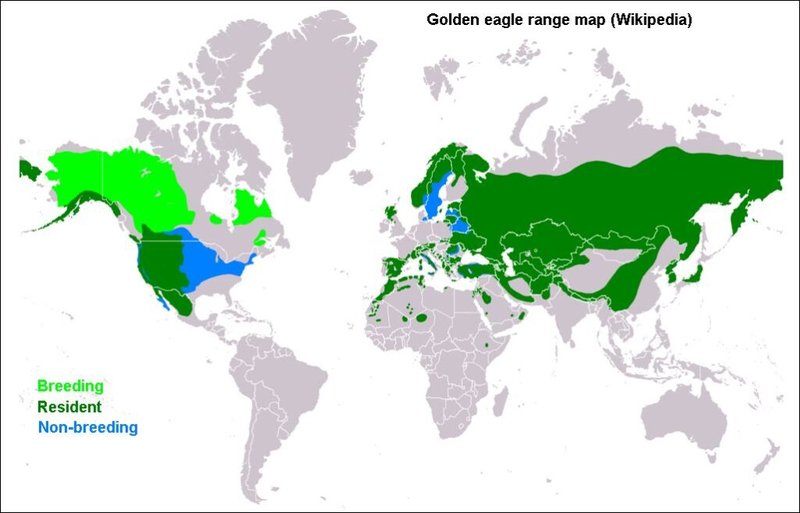
The golden eagle, a symbol of freedom and strength, has a wide range across the globe, adapting to various habitats from the rugged mountains of North America to the vast steppes of Central Asia. Understanding where to spot them can enhance your birdwatching adventures and deepen your appreciation for these amazing raptors. Let’s dive into the exciting world of golden eagles and explore their habitats, ranges, and the best spots where you might catch a glimpse of these incredible birds in action.
Understanding the Habitat of Golden Eagles
Golden eagles are versatile birds that thrive in various environments. Primarily, they prefer open and mountainous areas, often found at elevations ranging from sea level to over 10,000 feet. You might be wondering what makes these terrains so appealing. The answer lies in their hunting strategies. Golden eagles depend on open spaces for spotting their prey, which includes small mammals like rabbits and rodents.
These birds also enjoy wooded edges and cliffs, where they can nest in safety. They tend to avoid densely forested areas since those can limit their visibility and hunting effectiveness. If you’re looking for golden eagles, keep an eye out for them in alpine regions, grassy plains, and rocky outcrops. Just imagine standing on a cliff’s edge, binoculars in hand, scanning the horizon for that unmistakable silhouette against the sky.
North America: A Prime Spot for Golden Eagles
In North America, golden eagles are mainly found in the western states, particularly in the Rocky Mountains and the Sierra Nevada. Places like Yellowstone National Park and the Grand Canyon are excellent locations to observe golden eagles in their natural habitat. During the breeding season, these birds often return to the same nesting sites year after year.
You can hike in areas like the San Juan Mountains in Colorado, where these majestic birds ride the thermals high above, searching for their next meal. Early morning or late afternoon is the best time for eagle spotting, as this is when they are most active. If you’re lucky, you might see them performing breathtaking aerial displays or engaging in courtship flights—a sight that truly captures the essence of wildlife.
Europe: Nesting Grounds and Migration Routes
Golden eagles are widespread across Europe, particularly in the Scottish Highlands and the Alps. The rugged landscapes of these regions provide ample opportunities for spotting golden eagles. Scotland, in particular, is famous for its population of these birds, which occupy isolated mountain ranges and remote glens.
During the winter months, some golden eagles migrate to lower altitudes, making areas like the Pyrénées and Sierra de Guadarrama in Spain excellent spots for observation. Local wildlife reserves in these areas often host guided tours, which can enhance your chances of seeing these stunning birds up close. Imagine sharing the experience with fellow bird enthusiasts, all of you captivated by the sight of golden eagles soaring above.
Asia: The Vast Steppes and Mountains
In Asia, golden eagles can be spotted across countries such as Mongolia, Kazakhstan, and Tibet. The expansive steppes of Mongolia provide a perfect habitat for these birds, where they hunt small mammals in the diverse landscape. In fact, golden eagles have significant cultural relevance in Mongolia, where they are trained for traditional hunting.
The Tibetan Plateau is another incredible area to spot golden eagles. Here, they can glide over vast expanses, feeding on the plentiful prey. If you’re planning a trip to Asia, consider visiting during autumn, when eagles can often be seen migrating to warmer areas. Just think about witnessing these incredible birds against the backdrop of the breathtaking Himalayas.
Conservation Status of Golden Eagles
It’s worth mentioning that golden eagles face several challenges due to habitat loss and climate change. While they are classified as a species of Least Concern globally, specific populations may be declining. Protecting their habitats is essential for ensuring these magnificent birds continue to soar through our skies.
Organizations dedicated to wildlife conservation are making efforts to preserve golden eagle habitats and educate the public about these birds. If you’re passionate about nature, consider supporting wildlife conservation efforts in your area. Even something as simple as spreading awareness can make a difference for these majestic birds.
Tips for Spotting Golden Eagles
If you’re eager to see golden eagles in the wild, here are some tips to enhance your experience:
- Be Patient: Wildlife observation requires patience. Find a comfortable spot, bring your binoculars, and wait.
- Know Their Behavior: Golden eagles are typically more active during dawn and dusk. Early morning or late afternoon is ideal for spotting.
- Use Binoculars or a Telescope: A good pair of binoculars can help you see details from a distance. Consider a spotting scope for a closer look.
- Look for Signs: Watch for large birds soaring at higher altitudes or perched on cliff edges. Their size and wingspan distinguish them from other birds.
Where to Find Resources and Communities
Connecting with local birdwatching communities can also be incredibly beneficial. Websites and forums focused on wildlife observation often share tips on where to spot golden eagles. Birdwatching societies can also provide you with valuable resources, including guides to local hotspots and organized outing events. Here’s the thing: shared knowledge enriches the birdwatching experience, and you might just make some new friends along the way.
You can also find useful apps that help track bird sightings and provide information on different species. Many birdwatchers rely on these tools to record their experiences and share with others. Whether you’re a seasoned pro or just getting started, there’s a whole community out there ready to help you connect with nature.
Spotting a golden eagle is a thrilling experience that can deepen your connection with nature. These magnificent birds can be found in a variety of habitats across the globe, from the mountains of North America to the steppes of Asia. By understanding their preferences and habitats, and following some simple tips, you can enhance your chances of witnessing one of nature’s most awe-inspiring creatures.
So the next time you’re planning an outdoor adventure, consider focusing on golden eagle habitats. Whether it’s hiking in the wild or participating in a local birdwatching event, each step you take brings you closer to experiencing the beauty of golden eagles in the wild. Just think about it: each moment spent in nature is a step toward creating unforgettable memories with these majestic birds. Happy birdwatching!

